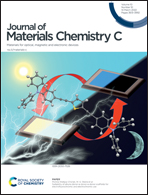Suitability of alkyne donor-π-donor-π-donor scaffolds for electrofluorochromic and electrochromic use†
Abstract
A series of electroactive materials consisting of an aromatic core that was conjugated with two alkynes and flanked with two triphenyl amines was investigated as electrochromes and electrofluorochromes. The yellow colored conjugated donor-π-donor-π-donor (D-π-D-π-D) alkynes could be electrochemically oxidized because of the terminal triphenylamine amines. The oxidation potential varied by 170 mV contingent on the central aromatic core (thiophene and EDOT) and whether the electroactive group was either unsubstituted or substituted with methyls in the 4,4′-positions. The emission of the chromophores was also contingent on the solvent and it spanned upwards of 90 nm. The emission yield was consistent (ca. 40%) and it was insensitive to the type of aromatic core, the triphenylamine substitution, and the solvent. The collective visible color and the electroactivity of the D-π-D-π-D compounds were ideal properties for electrochromic applications. The compounds underwent reversible color change from yellow to blue with the applied potential. The electrochromic devices fabricated from the D-π-D-π-D alkynes could be operated upwards of 15 hours and operating devices that were flexible could also be prepared. The intrinsic fluorescence of the D-π-D-π-D compounds could be reversibly turned-off with the applied potential, which enables them to be used in operating electrofluorochromic devices. Although the alkyne framework was robust for electrochromic use, it could react with tetracyanoethylene, leading to octanitrile substituted D-π-A-π-D-π-A-π-D chromophores that were red in color.



 Please wait while we load your content...
Please wait while we load your content...